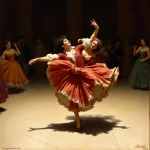Ballet: Le Beau Danube (Johann Strauss II, 1924)

Introduction
Ballet, an art form that combines music, dance, and storytelling, has produced numerous masterpieces over the centuries. One such gem is “Le Beau Danube,” a ballet choreographed by Léonide Massine with music composed by Johann Strauss II. Premiered in 1924, this ballet is a vibrant and whimsical portrayal of life along the Danube River, capturing the essence of Viennese culture and charm. The ballet’s plot revolves around a series of romantic and comedic encounters, set against the backdrop of Strauss’s enchanting waltzes and polkas.
Historical Background
Creation and Development
“Le Beau Danube” was created during a period of significant artistic innovation in the early 20th century. The ballet emerged in the context of post-World War I Europe, a time when artists were exploring new forms and expressions. Léonide Massine, a prominent choreographer of the Ballets Russes, sought to create a work that would capture the light-hearted spirit and elegance of Viennese life. The inspiration for the ballet came from the music of Johann Strauss II, whose compositions epitomized the gaiety and sophistication of 19th-century Vienna.
The collaboration between Massine and Strauss was pivotal in bringing “Le Beau Danube” to life. Massine’s choreography was designed to complement Strauss’s music, creating a seamless blend of dance and melody. The ballet also involved contributions from other key figures, including set and costume designers who helped to create the visual splendor of the production.
Premiere and Reception
“Le Beau Danube” premiered on April 17, 1924, at the Théâtre de la Gaîté-Lyrique in Paris. The initial reception was overwhelmingly positive, with critics and audiences praising the ballet for its charm, wit, and elegance. The combination of Strauss’s music and Massine’s choreography was seen as a perfect match, creating a delightful and entertaining experience. Notable early performances included revivals by the Ballets Russes and other prominent ballet companies, further cementing the ballet’s popularity.
Synopsis of the Ballet
One-Act Ballet
“Le Beau Danube” is a one-act ballet that unfolds in a series of lively and humorous scenes. The ballet opens with a bustling marketplace along the Danube River, where various characters interact and engage in playful antics. The central plot revolves around a young officer who becomes infatuated with a beautiful flower girl. Their budding romance is complicated by the presence of a flirtatious baroness and a comical street vendor, leading to a series of misunderstandings and humorous situations.
Key moments in the ballet include the officer’s attempts to woo the flower girl, the baroness’s flirtations, and the street vendor’s mischievous interventions. The ballet culminates in a grand ball, where the characters’ romantic entanglements are resolved in a joyous and celebratory finale.
Musical Composition
Composer’s Role
Johann Strauss II, known as the “Waltz King,” was a prolific composer whose music epitomized the elegance and charm of 19th-century Vienna. His compositions for “Le Beau Danube” include some of his most famous waltzes and polkas, such as “The Blue Danube” and “Tales from the Vienna Woods.” Strauss’s music plays a crucial role in the ballet, providing the rhythmic and melodic foundation for the choreography. The lively and infectious melodies enhance the narrative and emotions of the ballet, creating a captivating and immersive experience for the audience.
Musical Themes and Motifs
The music of “Le Beau Danube” is characterized by recurring themes and motifs that reflect the characters and their interactions. The waltzes and polkas are used to convey the light-hearted and playful nature of the ballet, while also highlighting moments of romance and comedy. The music’s rhythmic patterns and melodic lines are intricately woven into the choreography, creating a harmonious and dynamic interplay between dance and music.
Famous Recordings and Performances
Over the years, “Le Beau Danube” has been performed by numerous ballet companies and orchestras, resulting in several iconic recordings and performances. Notable recordings include those by the Vienna Philharmonic Orchestra and the Royal Concertgebouw Orchestra, which capture the elegance and vibrancy of Strauss’s music. These recordings have helped to preserve and popularize the ballet’s score, making it accessible to audiences around the world.
Choreography and Dance
Choreographer’s Vision
Léonide Massine’s vision for “Le Beau Danube” was to create a ballet that would capture the spirit and charm of Viennese life. His choreography is characterized by its wit, elegance, and playful energy, reflecting the light-hearted nature of Strauss’s music. Massine introduced several innovations in the choreography, including the use of character-driven dance sequences and comedic elements. His interpretation of the ballet emphasizes the interactions and relationships between the characters, creating a dynamic and engaging narrative.
Signature Dance Numbers
One of the standout dance numbers in “Le Beau Danube” is the Pas de Deux between the officer and the flower girl, which showcases their budding romance through graceful and expressive movements. Another key scene is the grand ball, where the characters come together in a lively and exuberant dance sequence. The choreography in these scenes reflects the characters’ emotions and relationships, using intricate footwork and expressive gestures to convey the story.
Notable Interpretations
Over the years, “Le Beau Danube” has been interpreted and adapted by various ballet companies, each bringing their own unique vision to the choreography. Some productions have emphasized the comedic elements of the ballet, while others have focused on the romantic and lyrical aspects. Notable interpretations include those by the Ballets Russes, the Royal Ballet, and the American Ballet Theatre, each of which has contributed to the ballet’s enduring popularity and appeal.
Characters and Roles
Main Characters
- The Officer: A young and dashing military officer who becomes infatuated with the flower girl. His character is charming and romantic, often engaging in playful and flirtatious behavior.
- The Flower Girl: A beautiful and innocent young woman who captures the officer’s heart. She is kind-hearted and graceful, embodying the elegance and charm of Viennese life.
- The Baroness: A flirtatious and sophisticated woman who complicates the officer’s romantic pursuits. Her character adds a touch of humor and intrigue to the ballet.
- The Street Vendor: A comical and mischievous character who provides comic relief and adds to the playful atmosphere of the ballet.
Supporting Characters
- The Market Vendors: Various characters who populate the bustling marketplace, adding to the lively and vibrant setting of the ballet.
- The Ball Guests: Characters who participate in the grand ball, contributing to the celebratory and joyous finale of the ballet.
Famous Dancers
Several notable dancers have portrayed the lead roles in “Le Beau Danube” over the years. These include renowned ballerinas and danseurs such as Alicia Markova, Rudolf Nureyev, and Margot Fonteyn, whose performances have left a lasting impact on the ballet’s legacy. Their interpretations of the characters have brought depth and nuance to the roles, enhancing the overall experience of the ballet.
Cultural and Artistic Impact
Influence on Ballet and Dance
“Le Beau Danube” has had a significant influence on the world of ballet and dance. Its innovative choreography and seamless integration of music and dance have inspired other choreographers and ballet companies. The ballet’s emphasis on character-driven storytelling and comedic elements has also contributed to the development of narrative ballet as an art form.
Cultural Significance
The ballet’s portrayal of Viennese life and culture has made it a beloved work in popular culture. “Le Beau Danube” has been referenced in literature, film, and other media, highlighting its enduring appeal and cultural significance. The ballet’s music, particularly Strauss’s waltzes, has also become iconic, further cementing its place in the cultural landscape.
Legacy and Revivals
“Le Beau Danube” continues to be performed and celebrated today, with major revivals and reinterpretations by leading ballet companies around the world. These modern adaptations often bring new perspectives and innovations to the ballet, ensuring its relevance and appeal to contemporary audiences. The ballet’s enduring popularity is a testament to its timeless charm and artistic excellence.
Iconic Productions
Historic Productions
Some of the most famous historical productions of “Le Beau Danube” include those by the Ballets Russes, which premiered the ballet in 1924. These early productions featured notable dancers such as Léonide Massine himself, who brought his unique vision and style to the choreography. The sets and costumes for these productions were designed by prominent artists of the time, adding to the visual splendor of the ballet.
Contemporary Productions
Recent productions of “Le Beau Danube” have continued to captivate audiences with their fresh interpretations and innovative choreography. Companies such as the Royal Ballet and the American Ballet Theatre have staged successful revivals, incorporating modern elements while staying true to the original spirit of the ballet. These contemporary productions often feature updated sets, costumes, and lighting design, creating a visually stunning experience for audiences.
Production Design
The production design for “Le Beau Danube” plays a crucial role in bringing the ballet to life. The sets typically depict a bustling marketplace and a grand ballroom, capturing the elegance and charm of Viennese life. The costumes are often elaborate and colorful, reflecting the characters’ personalities and the festive atmosphere of the ballet. Lighting design is also an important element, enhancing the mood and emotions of the scenes.
Critical Reception and Reviews
Initial Critical Response
At the time of its premiere, “Le Beau Danube” received widespread acclaim from critics and audiences alike. The ballet was praised for its delightful choreography, enchanting music, and charming portrayal of Viennese life. Critics highlighted the seamless integration of dance and music, as well as the engaging and humorous narrative.
Modern Reviews
Contemporary critics continue to appreciate “Le Beau Danube” for its timeless appeal and artistic excellence. The ballet is often lauded for its innovative choreography, captivating music, and vibrant production design. Modern audiences also enjoy the ballet’s light-hearted and entertaining nature, making it a popular choice for ballet companies around the world.
Fun Facts and Trivia
Behind-the-Scenes Stories
One interesting anecdote from the production of “Le Beau Danube” involves Léonide Massine’s collaboration with Johann Strauss II’s descendants. Massine sought their approval and input on the use of Strauss’s music, ensuring that the ballet would honor the composer’s legacy. This collaboration added an extra layer of authenticity and respect to the production.
Notable Performers
Over the years, many famous dancers have performed in “Le Beau Danube,” including Alicia Markova, Rudolf Nureyev, and Margot Fonteyn. These dancers brought their own unique interpretations to the roles, adding depth and nuance to the characters. Their performances have left a lasting impact on the ballet’s legacy.
Trivia
- “Le Beau Danube” is often referred to as “The Beautiful Blue Danube,” a nod to one of Johann Strauss II’s most famous waltzes.
- The ballet’s premiere in 1924 was part of a larger trend of incorporating popular music into ballet productions, reflecting the changing tastes and cultural influences of the time.
- Léonide Massine’s choreography for “Le Beau Danube” was influenced by his background in character dance, which emphasizes storytelling and expressive movements.
Conclusion
Summary of the Ballet’s Importance
“Le Beau Danube” is a significant work in the world of ballet, known for its charming portrayal of Viennese life, innovative choreography, and enchanting music. The ballet’s seamless integration of dance and music, along with its engaging narrative, has made it a beloved classic that continues to captivate audiences around the world.
Final Thoughts
Reflecting on “Le Beau Danube,” it is clear that the ballet’s enduring appeal lies in its ability to transport audiences to a world of elegance, charm, and whimsy. The collaboration between Léonide Massine and Johann Strauss II resulted in a masterpiece that has stood the test of time. For those who have not yet experienced this delightful ballet, it is highly recommended to watch a performance or listen to the score, as it offers a truly enchanting and memorable experience.
FAQ
What is the central theme of this ballet?
The central theme of “Le Beau Danube” is the light-hearted and whimsical portrayal of romantic and comedic encounters along the Danube River, set against the backdrop of Viennese culture and charm.
Who are the main characters in this ballet?
The main characters in “Le Beau Danube” include the Officer, the Flower Girl, the Baroness, and the Street Vendor, each of whom plays a key role in the ballet’s romantic and comedic narrative.
What is the most famous dance number in this ballet?
One of the most famous dance numbers in “Le Beau Danube” is the Pas de Deux between the Officer and the Flower Girl, which showcases their budding romance through graceful and expressive movements.
How long does a typical performance of this ballet last?
A typical performance of “Le Beau Danube” lasts approximately 30 to 40 minutes, as it is a one-act ballet.
Are there any modern adaptations of this ballet?
Yes, there have been several modern adaptations and revivals of “Le Beau Danube” by leading ballet companies around the world, incorporating contemporary elements while staying true to the original spirit of the ballet.
Why is this ballet considered important in the history of dance?
“Le Beau Danube” is considered important in the history of dance due to its innovative choreography, seamless integration of music and dance, and its charming portrayal of Viennese life. The ballet has had a significant influence on other works and continues to be celebrated for its artistic excellence.





